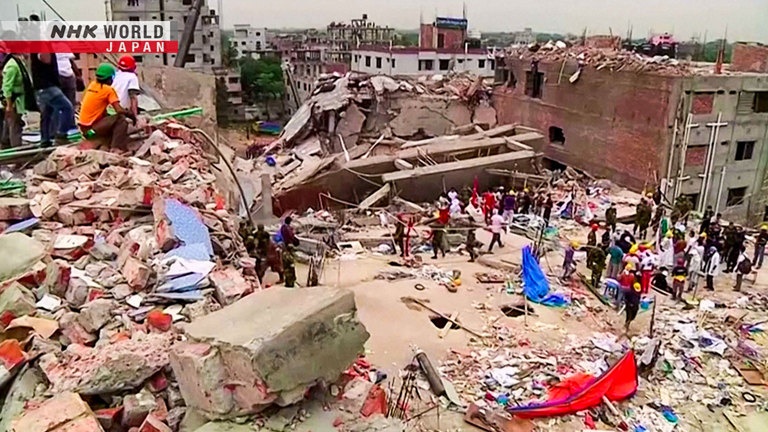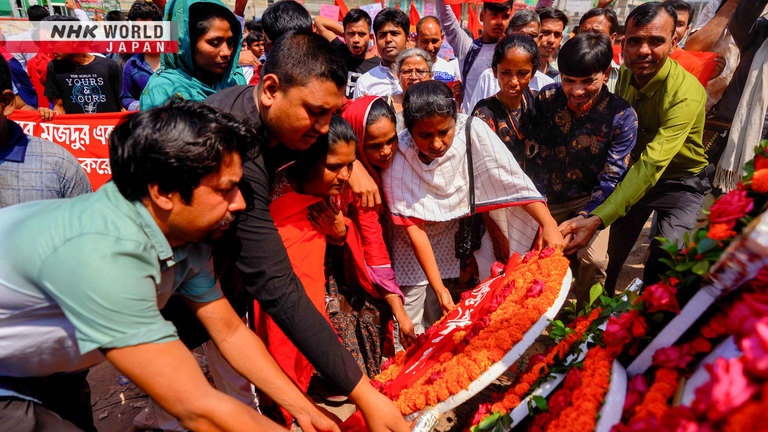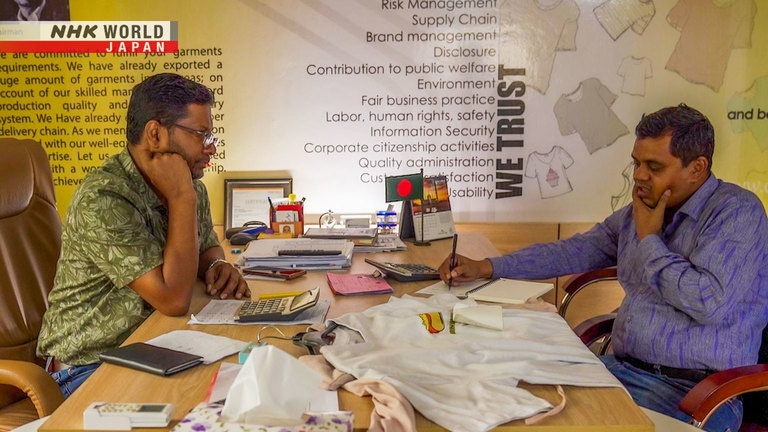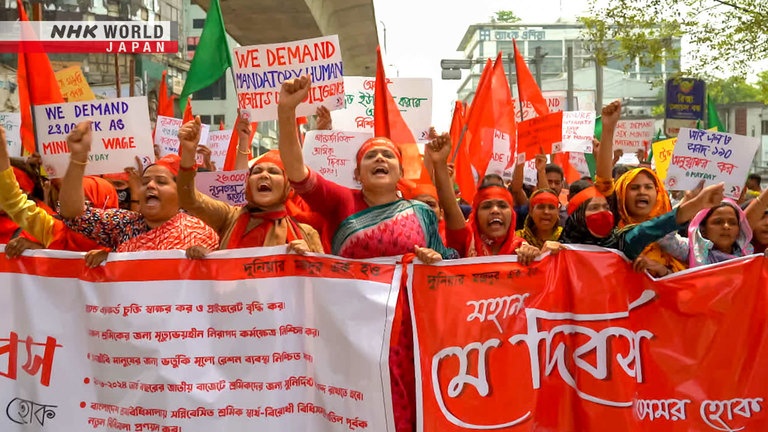Attempted Change in the Garment Industry: Bangladesh
Bangladesh is well known as an international garment producer, with 4.2 million people employed by the industry, many working in factories to sew apparel for overseas brands. But in 2013, the nation was shocked by an accident in which the collapse of an illegally expanded building holding several factories claimed more than 1,100 lives. The incident drew worldwide criticism and caused safety regulations to be imposed. Now caught between strict regulations, rising costs and the constant demand for lower prices from overseas buyers, factory owners and their employees find it hard to earn a living.




Transcript
Dhaka, the capital of Bangladesh.
On the outskirts of the city is an open plot of land surrounded by buildings...
10 years ago, it was the site of an industrial accident that shocked the world.
An 8-story building containing garment factories, Rana Plaza, suddenly collapsed.
More than 1,100 people died in the accident,
drawing attention to the negligent safety management of the building.
Bangladesh ranks as the world's second-largest garment exporter.
But this past tragedy served up an ultimatum for change in the industry.
The accident has changed the garment industry.
Following the accident, factories in Bangladesh began reinforcing their safety regulations.
However, the garment industry there struggles with rising costs and intense price competition.
Orders decreased, work stopped, and
we're facing a crisis.
Workers will be out on the streets.
Ten years have passed since the worst accident in the garment industry.
This episode examines the realities of garment production in Bangladesh.
With more than 20 million inhabitants, Dhaka has the world's highest population density.
Every day, migrant workers from all over Bangladesh gather to labor in the city.
Their most significant source of income is the garment industry.
The companies claim to have paid
enough compensation.
Who here has managed to receive it?
April 24th marks 10 years to the day since the collapse of the Rana Plaza building.
A memorial was held for its victims.
The roof caved in, paralyzing my right arm.
Life has been hard for me in the decade since.
My family and I spent the whole evening
looking for my son.
We could only tell it was him from
his clothing and belt.
He had just started working at 18.
We must fight to survive!
The Rana Plaza accident was murder.
The workers of the world must remember them.
- What's your name?
- Taslima Akhter, chairman of the workers' union.
Union chairman Taslima Akhter seeks to improve treatment of laborers involved in the garment industry.
Garment workers, band together!
We need to fight to survive!
The building collapsed here.
At the time, despite obvious wear to the building,
it had been illegally expanded to contain 5 garment factories.
The owners were fully aware of cracking in the walls,
and yet they prioritized their profits, forcing the workers to continue there.
And then, tragedy struck.
I climbed on top of the rubble four stories tall.
Taslima also works as a photographer.
When she heard news of the collapse, she rushed to the scene.
I saw so many bodies at the site.
There was one scene that called
out to me to photograph.
In 2013, this photograph was chosen by Time Magazine among their top 3 photos of the year,
informing the world of the tragedy that had occurred.
These two workers had tried to survive
until the very end.
I saw people who hadn't been treated
as humans.
They weren't just units of labor.
They had families and dreams.
They were just like us.
Around 40 people including the factory owners and construction developers were prosecuted for their responsibility in the accident.
Despite this, many victims and surviving families are still fighting to receive proper compensation.
A decade after the accident, Dhaka's tall buildings are still the location of many garment factories.
Factories making clothing for export number over 4,000 across the whole of Bangladesh.
The factories accept orders from apparel brands in Western nations and Japan,
answering consumer demand for the latest affordable fashion.
The garment export industry counts its abundant workforce as a major asset.
According to government-provided data, recent yearly export of garments generated 42.6 billion US dollars in sales,
more than 80% of total national export revenue.
In the past, the majority of factories with safety hazards had received their orders from overseas.
The accident has changed the garment industry.
Professor Shahidur Rahman specializes in Bangladesh's garment industry.
He recounts that the Rana Plaza incident had a major effect on image-conscious international clothing brands.
After the accident, the government and
industries encountered a problem.
International clients no longer wanted
to do business with factories here.
Countless factories were driven to
the brink of bankruptcy.
Businesses and local groups began working
together to prevent future accidents.
Following the accident, a new requirement was implemented among garment factories doing business with foreign clients.
Everyone, evacuate!
These evacuation drills are held to prepare for fires or industrial accidents in the factories.
Since the accident, evacuation drills
have been held every 3 months.
The costs are covered by the businesses
and paid to the fire department.
The tragedy of Rana Plaza taught us
an important lesson.
Domestic industrial groups and the government
have worked together, exchanging opinions.
We've made a number of improvements
in the name of safety.
In order to ensure safety and security in the garment industry, the RSC was established.
The RSC is composed of members of the domestic garment industry, workers' unions, and foreign brands,
cooperating to form a detailed standard for worker safety.
Inspectors make regular factory visits.
Garment factories not reaching the standards laid out by the RSC are prohibited from doing business with foreign brands.
One safety standard of the RSC is the provision
of fire safety equipment.
Then there's the safety of electrical equipment
such as cables.
A building containing a factory needs to
be able to support its weight with stability.
Based on these standards, 2,200 factories
underwent inspection.
Improvements were ordered and carried out.
Non-complying factories were shut down.
The RSC is using the bitter tragedy of Rana Plaza as an impetus to improve safety nationwide.
Some factories have progressively embraced international standards, seeking to refine their business image.
Our factory was built as Bangladesh received
international criticism over the accident.
We were highlighted as being among the world's
most environmentally friendly.
We've been certified as a green factory.
A green factory is one which has attained a high level of sustainability in production
while showing awareness of people and the environment.
This garment factory passed certification by an internationally recognized American standard.
The structure is designed to make ample use of natural light,
reducing need for artificial light and energy consumption.
Using renewable energy such as solar power, the factory constantly monitors its CO2 emissions.
International brands tend to favor green factories with their business.
This trend has led a wave of factories in Bangladesh to seek certification,
with the country's total number of green factories in the garment industry now numbering the highest in the world.
However, the effort has also lead to new conundrums.
Construction of green factories is 20% more
expensive than normal ones.
But buyers have no intention of paying more.
We need their understanding in order
to build more green factories.
Despite a rise in orders thanks to the improved image,
factories are driven into even more intense price competition.
Meanwhile, many factories feel that the safety rules imposed by the RSC are placing a considerable burden on their business.
Here are the water pump and fire hydrant.
This fire safety equipment was installed based on the regulations of the RSC.
The pump cost more than US$32,000.
Plumbing needs to connect each floor
and the roof.
Altogether, costs came to $37,000.
The expenditure was necessitated by the RSC.
Mohammad Kamruzzaman has operated a factory producing garments for export for the last 15 years.
The RSC provided us with a list of
safety equipment.
I purchased everything they requested.
Then later, another representative told us
that we needed even more.
Hoping to recover his considerable investment,
Kamruzzaman focused on making sales to foreign brands, but he encountered another problem...
Orders decreased, work stopped, and
we're facing a crisis.
We had work until 2 or 3 months ago.
What brought on this sudden lack of orders?
The war between Russia and Ukraine
drove up gas and utility prices.
Consumers' budgets got tighter,
and purchase power dropped.
Our orders all but stopped.
We're dealing with the fallout from that.
To maintain sales, factories are forced to lower the price per item.
But under pressure from the RSC to uphold safety measures,
it's hard to cut prices and still turn a profit.
Many small factories are on the verge
of going under.
This poses a clear loss to the country.
The garment industry is an essential field
that can be run by our citizens.
And yet small factories are having difficulty
staying in business.
What about the report?
To find a way through the harsh economic climate,
Kamruzzaman has been holding meetings with his section leaders,
but he says they have yet to find a solution.
We used to be called a top supplier,
but we've really fallen.
We aren't even in the top ten.
Workers set out for the factories each morning.
Some 4.2 million residents of Bangladesh are employed by the garment industry.
A decade since the Rana Plaza accident, safety standards have finally been improved.
However, whether workers' lives have been improved is a more complicated issue.
Moyna Begum is one of the garment factory workers.
I get up at 4:00 every morning,
and leave the house at 7:30.
It isn't easy, but it's my job.
I'm always short on sleep.
Moyna was born in a farming village outside Dhaka.
At age 13, she traveled to begin work in the garment factories.
My village is poor, and we have no way
to support ourselves.
I came to Dhaka to earn a living.
But after 23 years of work,
my life hasn't improved.
In the evening, the factory workers finish for the day and set off on the commute home.
Moyna stops to buy groceries so that she can prepare dinner for her family.
- How much is oil?
- $1.50.
- Can you go lower?
- Costs have risen.
Inflation is noticeable in Bangladesh.
In the past year in particular, rising food costs have placed a strain on local livelihoods.
The higher prices are hard on workers.
- Do you have rice in stock?
- Of course.
67 cents.
How about 64?
I can't.
- I'd buy it for that much.
- Nope.
No.
I'll go elsewhere.
We used to be able to buy a full bag
for less than 2 dollars.
Now it's more than five times that.
When Moyna began working in the factories 23 years ago, she earned only around 8 dollars a month.
Now she receives more than 10 times that, but the climbing prices have made it hard to get by.
It's hot here in the summer and
freezing in winter.
The kitchen and bathroom are shared
among 4 families.
Today we're having fried fish, potatoes,
and greens.
Their family of 4 lives in a 6 square meter room.
This is my son Alif and my husband Billa.
Here's my daughter, Jeem.
What do you do?
I'm a rickshaw man.
By pulling passengers in a rickshaw, Billa makes around 90 dollars a month.
Moyna earns about 110 dollars in the factory.
After paying the costs of living and their children's tuition,
they only have 5 dollars left over each month.
Even on our days off, we don't have enough
money to go anywhere.
Overseas buyers should give some thought
to the lives of this country's workers.
If they would just work with the factories
to raise our wages...
We could manage to save up some money.
Where can happiness be found among
the suffering in life?
Has Allah forgotten to bring happiness
to our fate?
Factory owner Kamruzzaman is still searching for a new solution.
His company has able to receive a north American order for 30,000 T-shirts.
With sales dwindling, he desperately needs the order, but the buyer has asked him to lower his price.
As the cost of materials has driven up, it won't be an easy decision.
Can you get the thread for $3 or less?
That'll be hard.
Want to cancel?
Without colored thread, it'd be 5 cents less.
No matter how low I cut my profits,
the buyer isn't satisfied.
Is there any point if there's no profit?
Buyers contact my factory asking for an estimate.
At the same time, they reach out to around
10 of my competitors.
When I say I can make T-shirts for $1.50 each,
competitors put out their own estimates.
The buyers always favor the cheapest factory.
If I don't get enough orders, I have no choice
but to accept their conditions.
It's awfully hard for smaller companies to survive
when large companies are competing.
The future of Bangladesh's garment industry continues to hang in the balance.
As the factory owners here pursue profits,
foreign brands hold influence over the country.
I don't want to have to take any more
photographs like Rana Plaza.
We need to create an environment where
people will be proud to work.
We're fighting for our lives.
May 1st, Workers' Day.
Laborers gather in central Dhaka to hold a rally.
Give workers their status and dignity!
Bangladesh continues to pay among the lowest wages in all of Asia.
I took part in the rally to ask for
higher wages and lower cost of living.
Workers will be out on the streets.
If buyers considered our lives at all,
we could get by somehow.
Between the workers and their families,
my factory supports around 1,500 lives.
If I give up, it'll be terrible for all of them.
That's the harsh reality, but we just have
to keep trying.
10 years since the Rana Plaza accident,
Bangladesh is looked upon as the world's foremost garment manufacturer now as much as ever.
While grappling with the precarious balance of their livelihoods,
factory owners and workers labor on in service of overseas consumers.